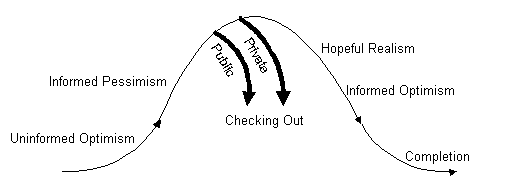cf.: Negative Response to Change

Source: Derived from Daryl Conner, Managing At the Speed of Change
- Uninformed Optimism.
Not enough is known about the change to really see the costs, but the benefits have been made clear. Remember that “Majored change decisions are always based on information that will later prove to be inadequate.” (p. 137) - Informed Pessimism
This stage always follows uninformed optimism. It is natural, and inevitable – Expect it!
- Checking Out
This differs from Informed Pessimism, in that Checking Out is a withdrawal from the change decision. Public checking-out can at least be addressed. Private checking-out goes underground, and takes forms such as resentment, sabotage, or undermining of the change efforts.
Whether or not a person checks out depends on each individual’s tolerance for pessimism (p. 139) - Hopeful Realism
There are still many issues to be resolved, but the light at the end of the tunnel can be seen. Most resistance has been overcome, and now it’s just an issue of doing the work. - Informed Optimism
Strong confidence in the success of the change effort earned through trial by fire.
- p.137- Major change decisions are always based on information that will later prove to be inadequate.
- p.138- “Informed pessimism” always follows uninformed optimism.
- p.138- Informed pessimism is a doubting of the change decision; checking out is a withdrawal from the change decision.
- p.139- Whether or not a person checks out depends on each individuals tolerance for pessimism.
- p.141- To manage change well you must use sober selling as your approach.
In the early stages of a project when enthusiasm is high, you must intentionally tell targets what the true costs of the change will be. - p.142-143- Anticipating informed pessimism does not mean that you can circumvent it.
- p.143- But since you know such things are at least in the realm of possibility, you are not as surprised that you were surprised.
